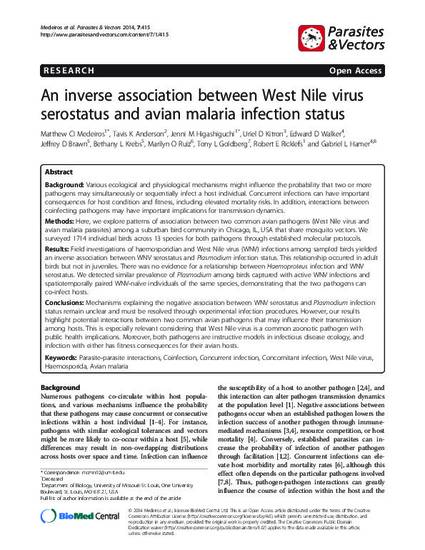
Article
An Inverse Association Between West Nile Virus Serostatus and Avian Malaria Infection Status
Parasites and Vectors
(2014)
Abstract
Background
Various ecological and physiological mechanisms might influence the probability that two or more pathogens may simultaneously or sequentially infect a host individual. Concurrent infections can have important consequences for host condition and fitness, including elevated mortality risks. In addition, interactions between coinfecting pathogens may have important implications for transmission dynamics.
Methods
Here, we explore patterns of association between two common avian pathogens (West Nile virus and avian malaria parasites) among a suburban bird community in Chicago, IL, USA that share mosquito vectors. We surveyed 1714 individual birds across 13 species for both pathogens through established molecular protocols.
Results
Field investigations of haemosporidian and West Nile virus (WNV) infections among sampled birds yielded an inverse association between WNV serostatus and Plasmodium infection status. This relationship occurred in adult birds but not in juveniles. There was no evidence for a relationship between Haemoproteusinfection and WNV serostatus. We detected similar prevalence of Plasmodiumamong birds captured with active WNV infections and spatiotemporally paired WNV-naïve individuals of the same species, demonstrating that the two pathogens can co-infect hosts.
Conclusions
Mechanisms explaining the negative association between WNV serostatus and Plasmodium infection status remain unclear and must be resolved through experimental infection procedures. However, our results highlight potential interactions between two common avian pathogens that may influence their transmission among hosts. This is especially relevant considering that West Nile virus is a common zoonotic pathogen with public health implications. Moreover, both pathogens are instructive models in infectious disease ecology, and infection with either has fitness consequences for their avian hosts.
Disciplines
Publication Date
August 1, 2014
DOI
10.1186/1756-3305-7-415
Citation Information
Robert Ricklefs, Matthew Ci Medeiros, Tavis K. Anderson, Jenni M. Higashiguchi, et al.. "An Inverse Association Between West Nile Virus Serostatus and Avian Malaria Infection Status" Parasites and Vectors Vol. 7 Iss. 415 (2014) p. 1 - 9 Available at: http://works.bepress.com/robert-ricklefs/381/
